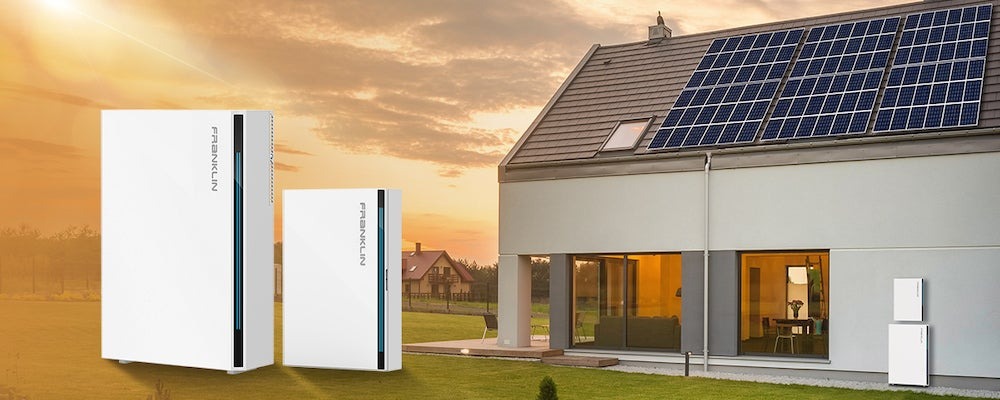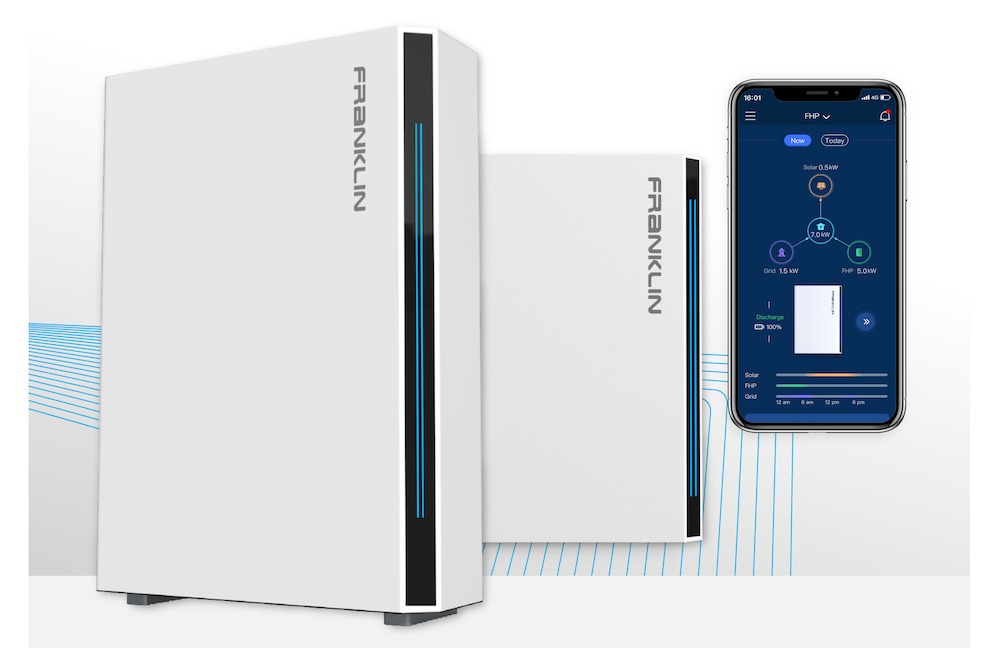Updated 9 months ago
FranklinWH Whole Home battery and Home Power System - expert review
Written by
Ben Zientara

Find out what solar panels cost in your area
FranklinWH is a newer company in the U.S. home energy storage market, but it could soon be a household name. It’s already a favorite among installers, being offered by 23% of installers who responded to our 2025 Solar Industry Survey, and it earned the 7th place spot on our Best Solar Batteries of 2025 list.
The WH stands for Whole Home, and the company is all about whole home backup. FranklinWH’s newest battery is the aPower2, now with higher storage capacity and power output than its predecessor.
If you’ve been looking for a home battery storage system, you might be very impressed with FranklinWH’s capabilities. Not many batteries on the market can match what FranklinWH claims its aPower2 system can do.
Does the FHP live up to these claims? Read on to find out!
Key takeaways
-
The FranklinWH battery system consists of a battery unit, smart energy management unit, and a smartphone app.
-
The FranklinWH battery can provide whole-home backup and charges from any solar inverter, AC generator, and the grid.
-
The aPower 2 batteries can store 15 kWh of energy and can release 10 kW of continuous power output.
-
The aGate handles smart energy management, automatically controlling battery charging and discharging and directing the flow of power to circuits in the home.
-
The FranklinWH Home Power System costs about $18,000 to install and offers excellent functionality like whole-home backup and generator charging.
The components of the FranklinWH Power System

The FHP consists of three components:
A 15-kilowatt-hour (kWh) lithium iron phosphate battery unit called the aPower 2
A smart energy management unit called the aGate
The FranklinWH smartphone app, which controls the smart circuits and allows users to customize their FHP system to their needs.
aPower 2 batteries
The aPower2 battery comes with its own inverter in a very nice-looking box, with a sleek design and a grouping of LEDs on the front that indicate the state of charge. Having the inverter included means it's an AC coupled battery, which connects to your home’s wiring only after the stored DC energy has been converted for use in your home.
One aPower 2 battery unit weighs in at 357 pounds and measures 45.2” × 29.5” × 11.8”. It can be mounted on the wall or on the ground. The battery unit holds 15 kWh of lithium iron phosphate (LFP) battery cells. The unit can output 10 kW of continuous power and surge to 15 kW for 10 seconds. This is enough to start a 5-ton air conditioner.
Each additional aPower unit adds battery capacity and power output. For example, two units can output 20 kW continuously and surge to 23 kW. As many as 15 aPower 2 battery units can be wired in parallel to a single aGate.
aGate smart energy management system
The aGate unit is where the battery meets the rest of the home. It has connections for the grid, the aPower battery, solar input, backup and non-backup loads panels, smart circuits, and a generator. The aGate can send power to all of your home’s appliances up to 200A, and can additionally manage some smart circuits to shut down certain loads when necessary.
There is room for up to three smart circuits inside the aGate, two 50A and one 80A. These can be connected to power-intensive appliances, EV chargers, or noncritical loads sub-panels and be set to automatically shut down if battery power is low in a grid outage situation through the app. You can also set schedules or manually control these smart circuits with the app.
The aGate controls battery charging and power flow in the home. It can be set to charge the batteries from solar, the grid, and even an AC backup generator. FranklinWH says the battery system can work with any existing solar inverter and accepts up to 80A of 240V output, which works out to about 19.2 kW. The wall-mounted aGate unit weighs 38.6 pounds and measures 31.5” x 21.7” x 6.3”.
One final selling point for the aGate is the ability to do “solar black start.” That means the battery system can operate completely independent of the grid using solar energy.
Essentially, the system will shut down if the battery gets too low during a power outage and there isn’t a backup generator available. The next morning as the sun comes up, the aGate will send a pulse signal to your solar inverter to check if it can produce enough power to start charging the battery. When it receives a positive response, the inverter will start up, the battery will start charging, and your home will be powered by your solar system.
The newest iteration of the aGate now supports “vehicle-to-home” functionality, allowing homeowners with electric vehicles to power their homes with their cars.
The company says future “vehicle-to-home” functionality is on its product roadmap, which would allow homeowners with electric vehicles to power their homes with their cars. It’s unclear whether the current aGate hardware can handle the functionality and the change will be software-only, or whether there will be a redesign or add-on for the aGate to make this functionality work.
The FranklinWH app
Using the FranklinWH app, owners can control how the battery charges and discharges. The battery can be set for self-consumption, backup standby, or load shifting, which means using backup power during peak usage times to save money under a Time of Use rate plan.
As mentioned above, the app also allows automatic scheduling of smart loads like EV chargers and other power-hungry appliances, along with manual control of these circuits during a power outage. During a grid outage, the aGate acts as its own wireless hotspot so you can still connect to the app and control the battery.
Finally, the app provides a real-time and historical display of energy generation, consumption, and battery use based on data from the aGate.
Cost and warranty
How much does a FranklinWH battery system cost?
The average cost to install a FranklinWH battery system with one aPower battery and one aGate is about $18,000 before incentives are considered. Around $15,500 accounts for the equipment and $2,500 for installation labor.
Additional aPower units can be purchased for $11,500 wholesale, with probably $1,000 for installation, depending on your location and installer.
That said, FranklinWH offers its installer partners different pricing and bonuses for selling a certain number of units, so you may find a better deal than the prices listed above. Also, your final cost is likely to be lower, considering the FranklinkWH battery qualifies for the federal clean energy tax credit.
FranklinWH battery warranty
For your money, you get all the functionality described above with a 15-year warranty, which covers defects in materials and workmanship as well as energy throughput. Specifically, FranklinWH says the aPower will retain at least 70% of its initial capacity by the end of the 15-year warranty or a minimum of 60 megawatt-hours (MWh) of throughput.
To put that into perspective, that means the aPower2 could be fully discharged and recharged 4,000 times before hitting its minimum throughput warranty. In order to get the full 15 years of coverage (4,383 days), you could discharge the battery an average of 10.9 kWh per day for the entire warranty period.
If the system suffers a defect within the warranty period, FranklinWH will repair the defective equipment or replace it with a new or refurbished battery.
Compared to other lithium-ion home batteries on the market, the FranklinWH battery system offers more features and is more expensive from a dollars-per-kWh perspective. In general, true whole-home backup is very expensive, and only the FranklinWH FHP is designed to do it out of the box.
The Generac PWRcell system can also do whole-home backup as long as you install a 32 kWh system and paired with Generac’s PWRmanager load control system.
And if you want true whole-home backup with the Tesla Powerwall, you’ll likely need at least two or three batteries to meet your needs.
Despite all this talk of whole-home backup, it’s important to note that none of the batteries described above are being marketed by their manufacturers for off-grid use, nor are they designed to provide backup to life-supporting systems or other medical equipment.
Here is a table with some comparisons between the FHP system and these other popular batteries:
Battery model | FranklinWH | Generac PWRcell | Tesla Powerwall 3 |
|---|---|---|---|
Average installed cost | $18,000 | $25,000 | $15,400 |
Power connection | AC | DC or AC | AC |
Capacity | 15 kWh | 18 kWh | 13.5 kWh |
Max. continuous output | 10 kW | 10.3 kW | 11.5 kW |
Round-trip efficiency | 90% | 88% | 90% |
Warranty | 70% after 15 years or 4 MWh of throughput per kWh of storage | 10 years or 2.52 MWh of throughput per kWh of storage | 70% after 10 years, unlimited cycles |
Generator integration | Yes | Yes | No |
Solar black start | Yes | Yes | No |
Exploring the numbers
As you can see from the numbers above, the FranklinWH FHP excels in some areas, like peak power output and warranty term. It’s also quite a bit more expensive on a dollars-per-kWh basis. But for people who need whole-home backup with generator integration, its ability to meet those needs without a lot of complicated and expensive electrical work is intriguing. Whether it’s worth it for you will depend on your specific needs and your tolerance for taking a risk on a relatively new company.
Unfortunately a simple comparison between batteries based on numbers alone isn’t possible. These battery systems can be configured in a number of ways which can impact their storage and power capabilities. The best way to see which battery system is right for you is by comparing quotes from installers who can help you figure out your storage needs.
About FranklinWH
FranklinWH Energy Storage, Inc. is a newcomer to the United States residential battery market. The company was founded in 2019 and is currently headquartered in San Francisco, CA. Before the FHP system, the company was mostly involved in creating power electronics for the utility-scale market.
The company has received funding from venture capital firms like Sequoia Capital and is now in what you might call aggressive growth mode. FranklinWH has been approved for financing through prominent companies like Mosaic and Goodleap, and is eligible for incentive programs like California SGIP.
Bottom line: Should you consider the FranklinWH battery for your home?
If you’ve been in the market for a whole home backup solution, you’ve probably noticed there are very few choices that don’t involve a whole lot of wiring and tens of thousands of dollars. If you look at the FranklinWH battery system that way, it seems positively elegant and affordable.
The functionality here is second to none in its price class, the tech is solid, and the company is doing the right things with certifications and getting the battery into the hands of installers. The concern here is it’s a relatively new product from a relatively new company, so you’ll have to trust that they’ll succeed and be around to support that 15-year warranty.
If that sounds like something you can live with, the FranklinWH battery gets our recommendation.
Ben Zientara is a writer, researcher, and solar policy analyst who has written about the residential solar industry, the electric grid, and state utility policy since 2013. His early work included leading the team that produced the annual State Solar Power Rankings Report for the Solar Power Rocks website from 2015 to 2020. The rankings were utilized and referenced by a diverse mix of policymakers, advocacy groups, and media including The Center...
Learn more about Ben Zientara